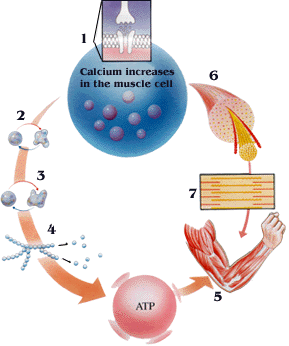Illustrated information
The Nobel Prize in Physiology or Medicine 1992
The Nobel Assembly at the Karolinska Institute in Stockholm, Sweden has awarded the Nobel Prize in Physiology or Medicine for 1992 jointly to Edmond H. Fischer and Edwin G. Krebs for their discoveries concerning reversible protein phosphorylation as a biological regulatory mechanism.

Breakdown of glycogen to glucose
Fischer and Krebs discovered how the breakdown of glycogen to glucose is controlled in the skeletal muscles, so that energy supply matches energy demand.

- Acetylcholine is released from a motor nerve. This causes an entry of calcium into the muscle cell.
- Calcium activates phosphorylase kinase – the first protein kinase discovered by Fischer and Krebs.
- Phosphorylase kinase phosphorylates phosphorylase, which is activated
- Glycogen is broken to glucose. This is used to generate ATP
- The muscle works and requires energy in the form of ATP
- The muscle contains muscle cells
- Contractile proteins in the muscle are activated by calcium
Proteins are the tools of the living organism
Proteins are composed of amino acids and have a defined three-dimensional structure. This form dictates the function. Proteins are responsible for all the reactions and activities of the cell. The structure of the individual proteins is encoded in DNA in the cell nucleus. Cytoskeletal proteins control the shape and movement of the cell.

Proteins are synthesized on ribosomes. Mitochondrial proteins are responsible for cell respiration and the synthesis of ATP that provides cellular energy. Enzymes in the cell catalyze chemical reactions. Storage vesicles contin, and release, hormones and neurotransmittors. They act on receptors and control ion channels. In this way cells can communicate with each other and order proteins in the cell to work in concert with the entire organism.
Reversible protein phosphorylation regulates most aspects of cell life
A key event in cell regulation is reversible protein phosphorylation. A protein kinase moves a phosphate group from ATP to the protein. Its shape and function is altered. A protein phosphatase removes the phosphate and the protein reverts to its original state.

Activation of the immune system
Activation of the immune system in response to a specific antigen illustrates how a series of protein phosphorylation and dephosporylation reactions convert a cell surface event to changes in DNA transcription and cell replication.
A protein phosphatase in the lymphocyte is activated (when contacting the antigen-presenting cell).

Credits and References for the 1992 Nobel Poster for Physiology or Medicine
Scientific Advisors, Professors at Karolinska Institutet:
Bertil Fredholm, Arne Holmgren, Hans Jörnvall and Alf A. Lindberg, Secretary of the Nobel Assembly.
Art Director: Urban Frank, Studio Frank, Stockholm, Sweden
Assistant: Stig Nordfeldt, Science Writer.
Copyright © The Nobel Committee for Physiology or Medicine at Karolinska Institutet, 1992
Web adapted version: Nobelprize.org
Every effort has been made by the publisher to credit organisations and individuals with regard to the supply of photographs and illustrations. The publishers apologize for any omissions which will be corrected in future editions.
Nobel Prizes and laureates
Six prizes were awarded for achievements that have conferred the greatest benefit to humankind. The 12 laureates' work and discoveries range from proteins' structures and machine learning to fighting for a world free of nuclear weapons.
See them all presented here.
